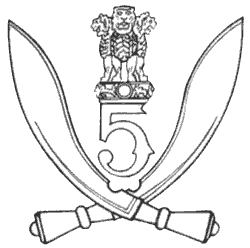
The 4th Indian Infantry Division, also known as the Red Eagle Division, is the infantry division of the Indian Army. This division of the British Indian Army was formed in Egypt in 1939 during the Second World War. During the Second World War, it took part in campaigns in East Africa, Syria, North Africa and Italy. Post independence, the division is part of the I Corps and headquartered at Prayagraj.

The 10th Princess Mary's Own Gurkha Rifles,, was originally a rifle regiment of the British Indian Army. The regiment was first formed in 1890, taking its lineage from a police unit and over the course of its existence it had a number of changes in designation and composition. It took part in a number of campaigns on the Indian frontiers during the 19th and early 20th centuries, before fighting in the First World War, the Third Anglo-Afghan War and the Second World War. Following India's independence in 1947, the regiment was one of four Gurkha regiments to be transferred to the British Army. In the 1960s it was active in the Malayan Emergency and Indonesian Confrontation. It was amalgamated with the other three British Gurkha regiments to form the Royal Gurkha Rifles in 1994.

5th Gorkha Rifles, also abbreviated as 5 GR(FF) is an infantry regiment of the Indian Army comprising Gurkha soldiers of Nepalese origin. It was formed in 1858 as part of the British Indian Army. The regiment's battalions served in the First World War (Mesopotamia) and Second World War.

The 5th Indian Infantry Division was an infantry division of the Indian Army during World War II that fought in several theatres of war and was nicknamed the "Ball of Fire". It was one of the few Allied divisions to fight against three different armies - the Italian, German and Japanese armies.
The Order of battle of the Chindits, an Allied special force which carried out two deep penetration raids behind Japanese line during the Burma campaign in the South-East Asian Theatre of World War II

The 8th Mountain Division was raised as the 8th Indian Infantry division of the British Indian Army. It is now part of the Indian Army and specialises in mountain warfare.

The 19th Indian Infantry Division was an infantry division of the Indian Army during World War II, and played a prominent part in the final part of the Burma Campaign.

The 17th Infantry Division is a formation of the Indian Army. During World War II, it had the distinction of being continually in combat during the three-year-long Burma Campaign. The division was re-raised in 1960 and 17 Mountain Division is presently located in Sikkim under XXXIII Corps.

The 7th Infantry Division is a war-formed infantry division, part of the Indian Army that saw service in the Burma Campaign.

The 23rd Indian Infantry Division was an infantry division of the Indian Army during World War II. It fought in the Burma Campaign. It was then reformed as a division of the independent Indian Army in 1959.

The 44th Indian Airborne Division was an airborne forces division of the Indian Army during World War II, created in 1944. It provided a parachute battalion for one minor airborne operation, but the war ended before the complete formation could take part..

The 25th Indian Infantry Division was an infantry division of the Indian Army during World War II which fought in the Burma Campaign. It was re-raised within the post-independence Indian Army in 1948.
The Burma Corps ('Burcorps') was an Army Corps of the Indian Army during World War II. It was formed in Prome, Burma, on 19 March 1942, took part in the retreat through Burma, and was disbanded on arrival in India in May 1942.

The 5th Indian Infantry Brigade was an infantry brigade formation of the Indian Army during World War II. It was converted from the 9th Indian Infantry Brigade in September 1939, and assigned to the 4th Indian Infantry Division. The brigade first moved to Egypt and took part in the early battles in North Africa. Then in 1941, it moved to the Sudan with the 5th Indian Infantry Division. Returning to 4th Indian Division command it took part in the Syria-Lebanon Campaign. The brigade then returned to North Africa coming under command of the 5th and 10th Indian Infantry Divisions, and the 50th (Northumbrian) Infantry Division and the 51st (Highland) Infantry Division in the Campaign in Tunisia. The brigade once more returned to the 4th Division for the Italian Campaign and the Greek Civil War.
The 17th Indian Infantry Brigade was an infantry brigade formation of the Indian Army during World War II.
The 100th Indian Infantry Brigade was an infantry brigade formation of the Indian Army during World War II. It was formed in April 1920 at Jhansi. The brigade was assigned to the 34th Indian Infantry Division until June 1943, when it was transferred to the 20th Indian Infantry Division until the end of the war. It was known for its participation in Battle of Imphal or known as "Imphal Campaign" where it fought along with other Indian Infantry regiments converged to form the 20th Indian Division and drove back the Japanese Army back to Burma inflicting heavy losses. This was a turning point in the Burma Campaign, part of South-East Asian theatre of World War II.
The 10th Indian Infantry Brigade was an infantry brigade formation of the Indian Army during World War II. It was formed in September 1939. In June 1940 it was assigned to the 5th Indian Infantry Division and in September 1940, sailed for East Africa. The brigade spent time attached to other formations, the 4th Indian Infantry Division between June 1940 and March 1941, and the British 10th Armoured Division between March and June 1942, where it was destroyed during the Battle of Gazala. A new brigade was formed in Egypt and assigned to the 10th Indian Infantry Division, with which it fought in the Italian Campaign from April 1944 until the end of the war.
The 20th Indian Infantry Brigade was an infantry brigade formation of the Indian Army during World War II.
The 21st Indian Infantry Brigade was an infantry brigade formation of the Indian Army during World War II.
The 25th Indian Infantry Brigade was an infantry brigade formation of the Indian Army during World War II. It was formed in February, 1941 at Ahmednagar in India and assigned to the 10th Indian Infantry Division. The brigade was attached to the 8th Indian Infantry Division in August 1941, and took part in the Anglo-Soviet invasion of Iran. Returning to the 10th Indian Division in August 1941, they arrived in the desert just in time for the Battle of Gazala and continued to fight in the Western Desert Campaign and later in the Italian Campaign. While in Italy the brigade was attached to the British 46th Infantry Division from 7 to 11 December 1944.














